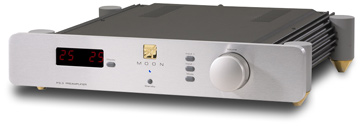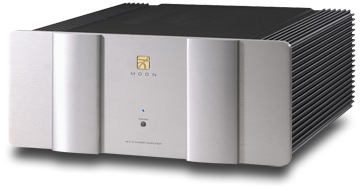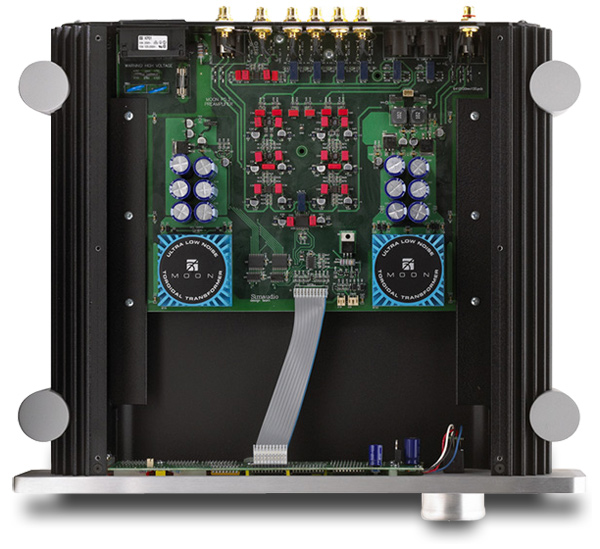 |
|
| October 15, 2007 Simaudio Moon Classic Series P5.3 Preamplifier and W5.3 Stereo Amplifier
My interest had been piqued by Jeff’s glowing review of the Moon Evolution Andromeda CD player, P-8 preamp, and W-8 power amplifier -- a combination that won Ultra Audio’s coveted Product of the Year designation for 2006. The P-8 and W-8 together retailed at $21,500; the Classic Series units I review here come in at a considerably more pocket-friendly $8800 -- still not exactly budget-class. The P5.3 preamp offers an optional moving-magnet/moving-coil phono-stage board ($450), but since I’m temporarily (I hope) bereft of an analog source, my review sample had only a line stage. Inside and outside Simaudio’s literature makes a point of stressing its products’ appearance, advanced engineering, and ease of use. The Moon P5.3 preamplifier and W5.3 amplifier measured up to those claims. The low-slung preamp is elegantly attractive, with rounded corners and cylindrical accordion side vents -- features it shares with the W5.3. The power amp’s form, however, follows its function: it’s a big, bulky box that practically screams "muscle power." An air of elegance is retained by the front panel, which sports only the Moon logo, an On/Off button, and a discreet blue LED that glows gently when the W5.3 is powered up. Both of my review samples were finished in black; they effectively disappeared from view, especially when the preamp’s display was turned off. Simaudio meets its goal of advanced engineering in both models. The preamp’s rotary volume control takes you from 0dB to 50dB via a "precision optical encoder which selects high quality metal-film resistors," through which the audio signal passes. This proprietary gain circuit is said to eliminate the degradation of the signal common to potentiometer-based circuits. Simaudio estimates that the volume-control system has a minimum life expectancy of one million rotations, a claim I had no desire to test. Other features include five inputs, one of them balanced using XLR connectors, the others single-ended via RCA connectors. Also on the rear panel are three pairs of outputs: single-ended, balanced, and a third pair intended for use with recording devices. The W5.3 power amplifier is rated at 150Wpc into 8 ohms or 300Wpc into 4 ohms. It includes proprietary technology that is claimed to "eliminate feedback," produce more accurate sound, and virtually eliminate transient intermodulation distortion and phase errors. There’s also an oversized power supply, a proprietary toroidal transformer that’s claimed to increase current speed and improve dynamics, and short signal paths (other features are described on Simaudio’s website). Both models have a rear-panel On/Off rocker switch and front-panel standby button; they’re designed to be left on at all times to reduce warmup time. Each comes with a well-written manual, an AC cable, and, in the case of the preamp, a hefty, all-aluminum remote control that includes all the functions you’re likely to use, including turn-on of source components. As for the claim of user-friendly ease of operation, I was impressed. The Moon 5.3s are logically laid out, the instructions are clear, and operation was a strictly no-hassle affair.
System I inserted the P5.3 preamplifier and W5.3 amplifier in my reference system, which included the Denon Exemplar DVD-3910 universal player, a Metronome Signature CD transport and DAC, the Wyetech Opal and Reimyo 777 line-stage preamplifiers, modified Jadis JA-80 monoblock power amplifiers, Von Schweikert VR-4 Gen.III HSE loudspeakers, and Siltech interconnects and speaker cables. (Thanks to Siltech America’s Ethan Wood for lending me jumper cables that match my other Gen.3 Siltechs and thus helping to preserve the domestic peace, which had been threatened by my need to run two long pairs of speaker cables across the living-room floor. Biwired speakers and a centrally located equipment rack housing the Moon W5.3 meant a bit of location juggling to mollify my outraged wife.) Accessories included the high-performance, high-value Vibrapod Isolators and Cones, Harmonix footers, L’art du son disc-cleaning fluids, and a Bedini Ultra Clarifier. My listening room is about 21’ long by 18’ wide, with the equipment along a short wall. The ceiling height is about 8.5’ -- fairly generous by Manhattan apartment standards. The Sound of the Moons When digging in for some serious listening, I usually start with solo piano, violin, or soprano voice, as these tell me what I most need to know. One thing the Moon 5.3s told me was that they love the piano. That was evident from the way they reproduced Anthony di Bonaventura’s recording of 14 sonatas by Domenico Scarlatti [CD, Centaur 2787], engineered by the legendary Marc Aubort. Scarlatti wrote these elegant miniatures for the harpsichord, of course, but di Bonaventura is unabashedly pianistic in his use of the full range of colors and gradations of touch available from a modern concert grand -- a source of dismay among period fundamentalists, but a source of enjoyment for the rest of us. Through the Moons the piano timbres were true, the colors of the different sonatas varied, and the dynamic range realistic. But what really got to me was the way the 5.3s handled microdynamics -- those slight gradations of touch that are crucial to bringing a performance to life. It’s all too rare that we hear those vital nuances from digital recordings, and especially from recordings played through solid-state electronics. The Scarlatti CD told me two other important things about the Moon duo. One is something I’d already known but had never fully realized in my gut -- that the gap between solid-state and tubes is closing fast. Between first-rate units of both types, perhaps that gap has already closed. The other important thing I discovered came when the serious, note-taking stage of the listening process ended and I returned to my reference system. Those important microdynamics were even more apparent through the tubed electronics, the piano had a tad more bloom, and the colors were even more varied. I’ll have more to say about this later on, but all of the following comments on the sound of the recordings I listened to through the Moons are based solely on my listening notes, which were made in direct, unfiltered response. By that criteria, another piano recording, the two-CD set of Keith Jarrett’s The Carnegie Hall Concert [ECM 1989/90], impressed. This set is the most successful of Jarrett’s live, improvised solo recordings that I’ve heard. Most important was the emotional engagement that occurred when listening to his fascinating mix of sources, which range from stride piano, funky blues, Art Tatum-like cascades of notes covering the entire keyboard, hair-trigger mood changes, and avant-garde contemporary musics. For one man to have absorbed all of these (and more) influences is impressive; for him to have knotted them together into a comprehensive, emotionally satisfying whole is an even greater accomplishment. And that points to yet another critical element that made my time with the Moon 5.3s so enjoyable. At the top of my list of audio priorities is the elusive one of the emotional integrity of the performances. I found that Jarrett’s range of colors, rhythms, and articulation, and the fine reproduction of Carnegie Hall’s acoustic, while important in assessing equipment, don’t really amount to as much as many of us believe. Instead, the paramount question I want a positive answer to is: "Does this equipment convey the emotional integrity of the music, and does it aid or hinder my response to the music and the performer(s)?" By that standard, the Moons scored high. Further confirmation came from another stellar set, Bach’s Sonatas and Partitas for Unaccompanied Violin, played by Christian Tetzlaff [CD, Hänssler 5287318; also available from Musical Heritage Society]. Tetzlaff has a reputation as a thinking man’s violinist whose carefully considered interpretations probe musical depths -- as opposed to players who revel in sheer virtuosity and flash to make their marks. What makes Tetzlaff so special, though, is that his virtuosity is complete: his technical command of his instrument matches his intellectual command of the music. This can be heard in his subtle use of rubato, the way he clearly delineates the many strands of these works’ fugal movements, the breathtaking accuracy of his double stopping, and the firmness of his tone from the top to the bottom of the violin’s range. Through the Moons, any fears I might have had that the top notes would sound too shrill or piercing were quickly allayed; the engineering captures Tetzlaff’s sweet high notes precisely as I’d heard them in concert. Turning to the soprano voice, I was curious to hear Anna Netrebko’s Russian Album, a disc of arias and songs drawn from her native repertoire [CD, Deutsche Grammophon B0008153]. A few months earlier I’d seen her at the Metropolitan Opera in Bellini’s I Puritani, and the sound of her thinnish lyric soprano was indelibly burned into my aural memory bank. Yes, there was a touch more bloom to the voice at the Met, but the Moons captured Netrebko’s basic sound and quality, an attractive hint of frailty well caught by the electronics, with nary a shred of the shrillness I’d feared might be an unavoidable artifact of solid-state electronics. If anything, the Moon 5.3s excelled in the higher frequencies. The mid-treble was smooth and detailed, and the complex overtones of the higher reaches were resolved with aplomb, as was obvious in an important reissue of the percussion music of the modernist Charles Wuorinen [CD, Naxos 8.559321]. On this disc, the array of cymbals, marimbas, and bells shimmered and glowed, and the timpani and drums were reproduced with satisfying depth. Transients, too, were lightning fast, and the leading edges of attacks were as good as I’ve heard in my system. The soundstage was impressively wide, with good depth and layering -- I could virtually "see" where the instruments were located. One oddity I find hard to explain is that while some discs boasted impressive soundstaging and solid bass, others did not, even after some speaker-placement tweaks that made some marginal improvements. So the band and singers on James Cotton’s Baby, Don’t You Tear My Clothes [CD, Telarc CD-83596] seemed chained to the space between the speakers, and while bass was insistent, it lacked some of the tightness and depth I’d heard through my reference system. On the other hand, I had the opposite reaction to the newly remastered SACD edition of Charles Munch and the Boston Symphony’s classic recording of Berlioz’s Harold in Italy [RCA Living Stereo 08280]. The soundstage of both the two-channel SACD and CD layers was as wide as I remember it from the original LP, and the recording was impactful throughout the tonal spectrum. I never felt, before or after, that the bass was lacking. Nor, on listening to the two-channel CD and SACD layers of the fabulously well-recorded Russian Nights, with Erich Kunzel and the Cincinnati Pops Orchestra [SACD, Telarc SACD-60657], could I hear any lack of soundstage width or bass punch. Conclusion Most audiophiles don’t have on hand stocks of various components that they can cycle in and out of their systems -- especially those of us more interested in the music than in endless tweaking and comparing the vessels through which the music is reproduced. For me, the ultimate test of any component I’m reviewing is whether or not I can live with this gear as a permanent part of my reference system. In the case of the Simaudio Moon Classic P5.3 preamplifier and W5.3 amplifier, the answer was "Yes." True, when the review process ended and I returned to my tube-based reference system, I preferred it to the Moon gear. It had more of the liquidity and warmth I crave in music, attributes that are invariably present in live, unamplified music heard from a good seat in a good hall. But the important point here is that, while living with and constantly listening to the Moons for many months, I never felt deprived. Yes, I was aware of the tradeoffs, such as the ease and convenience of the Moons vs. the annoyance that’s part and parcel of the tube experience: the longer warmup times, the fear of the dreaded tube burnout, the need to regularly replace aging tubes. As one audio engineer told me, "When I put new tubes into my recording equipment, I always say, ‘It’s all downhill from here.’ " It’s axiomatic that achieving the last 5-10% of audio perfection (a moving target in itself) comes at an awesome price. In this instance, my reference electronics retail at more than three times the price of the Moon Classic 5.3s. So unless you’re a well-heeled perfectionist endlessly chasing the state of the art, the Moons will give you almost all of what you crave. Value may be a relative term, but to me, Simaudio’s Moon Classic P5.3 and W5.3 represent outstanding value in a marketplace where you could spend much more and get much less. …Dan Davis Simaudio Moon P5.3 Preamplifier Simaudio Ltd. E-mail: info@simaudio.com
Ultra Audio is part of the SoundStage! Network. |



